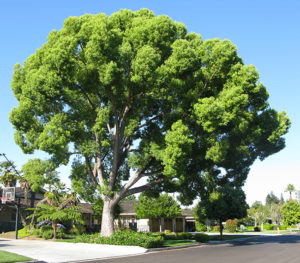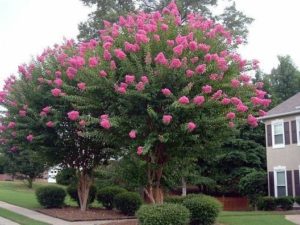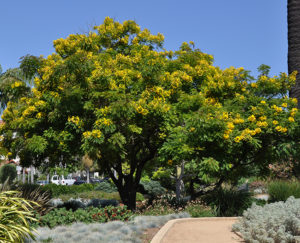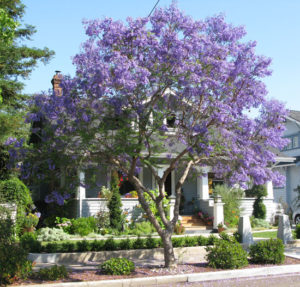Whether you’re celebrating Arbor Day, Earth Day, or you just love the beauty and function of trees, there are several things to remember when preparing to plant a tree:
- Trees are alive! Just because you put a tree in the ground doesn’t mean it’s going to thrive. You need to do a little research about the kind of soil, nutrients, and amount of sun and water it requires to survive.
- Trees can get big! Choose the location for your tree carefully, keeping in mind the size the root ball and canopy will be when the tree is mature. Roots can pose a major problem when trees are planted too close to buildings or sidewalks.
- Trees are a long term commitment! Many of us would love to jump forward in time to when our tree is mature and majestic, providing shade and enhancing the beauty of our property. But trees take years and sometimes decades to reach maturity. When we plant trees we are making an investment in the future. Just how far that investment will reach depends on the type of tree we choose.
Choose Wisely
Keeping these things in mind plus facts about which trees do well in which climates, our Consulting Arborist Jeff Cloud has assembled this list of winners for Southern California:
Drought Tolerance
If you live in an area with water restrictions or are concerned primarily with ongoing drought conditions you may want to consider a more drought tolerant species such as acacia, mesquite or palo verde.
Camphor Tree
 The camphor tree (cinnamomum camphora) is an attractive, fragrant tree that can grow a large, evergreen canopy. Perfect for beautifying and shading a property, its leaves and flowers are also fragrant and are used to make camphor oil, which has many surprising health benefits. It can grow to a height of 65′ at a rate of 24″ per year and requires amble growing space.
The camphor tree (cinnamomum camphora) is an attractive, fragrant tree that can grow a large, evergreen canopy. Perfect for beautifying and shading a property, its leaves and flowers are also fragrant and are used to make camphor oil, which has many surprising health benefits. It can grow to a height of 65′ at a rate of 24″ per year and requires amble growing space.
Silk Tree

The silk tree (albizia julibrissin) is another attractive shade tree, though one that doesn’t grow as tall as the camphor. The silk tree has a low, spreading canopy and will grow to a height of 20-35′ at a rate of 36″ per year. It has pretty, pink flowers and sheds its leaves annually so it can create a mess on the property. But regular sweeping may be worth it to you for this beautiful tree.
Crape Myrtle
 The crape myrtle (lagerstroemia indica) is a familiar sight in Southern California. Its aromatic flowers, which bloom in the Summer, and spreading, low canopy make it a popular choice for a variety of property types. It can grow to a height of 25′ at a rate of 24″ per year and may live up to 150 years! Another deciduous tree, you’ll have to decide whether the mess is worth the beauty of this tree.
The crape myrtle (lagerstroemia indica) is a familiar sight in Southern California. Its aromatic flowers, which bloom in the Summer, and spreading, low canopy make it a popular choice for a variety of property types. It can grow to a height of 25′ at a rate of 24″ per year and may live up to 150 years! Another deciduous tree, you’ll have to decide whether the mess is worth the beauty of this tree.
Gold Medallion Tree
 We love the brilliant yellow flowers of the cassia leptophylla, another tree commonly seen in Southern California and with good reason! Growing to a height of 20-25′ at a rate of 36″ per year, this tree’s low, spreading canopy and partly deciduous foliage make it a great candidate for many properties. One potential drawback to homeowners is that it rarely lives longer than 50 years.
We love the brilliant yellow flowers of the cassia leptophylla, another tree commonly seen in Southern California and with good reason! Growing to a height of 20-25′ at a rate of 36″ per year, this tree’s low, spreading canopy and partly deciduous foliage make it a great candidate for many properties. One potential drawback to homeowners is that it rarely lives longer than 50 years.
Jacaranda
 Jacaranda mimosifolia is known primarily for its vibrant lavender flowers which seem to envelope the tree in a blue cast when in bloom. Unfortunately, these flowers can eventually cause a sticky, blue mess on sidewalks below. Growing to a height of 40 – 50′ at a rate of 24″ per year, this showy tree can live up to 150 years! it’s hard to surpass the beauty of this tree when it’s in bloom. But you better have a broom handy….
Jacaranda mimosifolia is known primarily for its vibrant lavender flowers which seem to envelope the tree in a blue cast when in bloom. Unfortunately, these flowers can eventually cause a sticky, blue mess on sidewalks below. Growing to a height of 40 – 50′ at a rate of 24″ per year, this showy tree can live up to 150 years! it’s hard to surpass the beauty of this tree when it’s in bloom. But you better have a broom handy….
Chinese Flame Tree
 The Chinese flame tree (koelreuteria bipinnata) is another flowering tree with a spreading, low canopy and deciduous foliage, which means it can create a mess. However, its slow growth rate (12-24″ per year to a height of 20 – 40′) and compact shape can make it an ideal choice for commercial properties and homeowner communities.
The Chinese flame tree (koelreuteria bipinnata) is another flowering tree with a spreading, low canopy and deciduous foliage, which means it can create a mess. However, its slow growth rate (12-24″ per year to a height of 20 – 40′) and compact shape can make it an ideal choice for commercial properties and homeowner communities.
Whichever tree you choose, remember the words of the founder of Arbor Day, J. Sterling Morton: “The simple act of planting a tree represents the belief that the tree will grow and, some day, provide… inspiration for ourselves and our children.”
